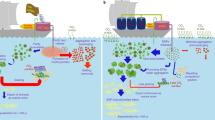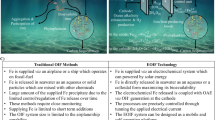Abstract
The global potential for renewable energy production far exceeds global energy demand. However, the accessibility of renewable energy is constrained by existing land use, the need to preserve protected areas and the costs associated with transporting energy over large distances. As a consequence, finite renewable energy capacity must be carefully matched to appropriate end uses. In this Perspective, we advocate the production of green ammonia on the ocean to address this policy challenge: local renewables should be used to generate electricity with high efficiency, whereas comparatively low-efficiency chemical energy storage in the form of ammonia should occur further away from energy consumers and be transported at relatively low costs. We describe the synthesis processes to be adopted, the techno-economic basis for this resource allocation, and the technical developments required that can enable this energy system to be established.

This is a preview of subscription content, access via your institution
Access options
Subscribe to this journal
Receive 12 digital issues and online access to articles
$119.00 per year
only $9.92 per issue
Buy this article
- Purchase on Springer Link
- Instant access to full article PDF
Prices may be subject to local taxes which are calculated during checkout



Similar content being viewed by others
References
Oil and Petroleum Products Explained (US Energy Information Administration, 2022); https://www.eia.gov/energyexplained/oil-and-petroleum-products/imports-and-exports.php
Carter, L., Quicke, A. & Armistead, A. Over a Barrel: Addressing Australia’s Liquid Fuel Security (The Australia Institute, 2022); https://australiainstitute.org.au/wp-content/uploads/2022/04/P1036-Over-a-barrel_liquid-fuel-security-WEB.pdf
Devlin, A. & Yang, A. Regional supply chains for decarbonising steel: energy efficiency and green premium mitigation. Energy Convers. Manage. 254, 115268 (2022).
Hydrogen: A Renewable Energy Perspective (International Renewable Energy Agency, 2019); https://www.irena.org/publications/2019/Sep/Hydrogen-A-renewable-energy-perspective
Cesaro, Z. The Role of Green Ammonia in Sector Coupling and Seasonal Electricity Storage (Univ. Oxford, 2021); https://www.ammoniaenergy.org/wp-content/uploads/2021/11/20211105_ZCesaro_AEAConference_noappendix.pdf
Innovation Outlook: Renewable Ammonia (International Renewable Energy Agency & Ammonia Energy Association, 2022).
Navigating the Way to a Renewable Future: Solutions to Decarbonise Shipping. Preliminary Findings (International Renewable Energy Agency, 2019); https://www.irena.org/publications/2019/Sep/Navigating-the-way-to-a-renewable-future
Valera-Medina, A., Xiao, H., Owen-Jones, M., David, W. I. F. & Bowen, P. J. Ammonia for power. Prog. Energy Combust. Sci. 69, 63–102 (2018).
Renewable Energy Hub in Australia (British Petroleum, 2023); https://www.bp.com/en_au/australia/home/who-we-are/reimagining-energy/decarbonizing-australias-energy-system/renewable-energy-hub-in-australia.html
Moriarty, P. & Honnery, D. What is the global potential for renewable energy. Renew. Sustain. Energy Rev. 16, 244–252 (2012).
Deng, Y. Y. et al. Quantifying a realistic, worldwide wind and solar electricity supply. Glob. Environ. Change 31, 239–252 (2015).
Windemer, R. Considering time in land use planning: an assessment of end-of-life decision making for commercially managed onshore wind schemes. Land Use Policy 87, 104024 (2019).
Katsouris, G. & Marina, A. Cost Modelling of Floating Wind Farms (ECN, 2016); https://questfwe.com/wp-content/uploads/2018/02/Cost-Modeling-of-Floating-Wind-Farms-ECN-2016.pdf
Feldman, D. et al. U.S. Solar Photovoltaic System and Energy Storage Cost Benchmark: Q1 2020 (National Renewable Energy Laboratory, 2021); https://www.nrel.gov/docs/fy21osti/77324.pdf
Dugger, G. L. & Francis, E. J. Design of an ocean thermal energy plant ship to produce ammonia via hydrogen. Int. J. Hydrog. Energy 2, 231–249 (1977).
Wang, H., Daoutidis, P. & Zhang, Q. Harnessing the wind power of the ocean with green offshore ammonia. ACS Sustain. Chem. Eng. 9, 14605–14617 (2021).
Salmon, N. & Bañares-Alcántara, R. Impact of grid connectivity on cost and location of green ammonia production: Australia as a case study. Energy Environ. Sci. 14, 6655–6671 (2021).
Beerbühl, S. S., Fröhling, M. & Schultmann, F. Combined scheduling and capacity planning of electricity-based ammonia production to integrate renewable energies. Eur. J. Oper. Res. 241, 851–862 (2015).
Nayak-Luke, R. & Bañares-Alcántara, R. Techno-economic viability of islanded green ammonia as a carbon-free energy vector and as a substitute for conventional production. Energy Environ. Sci. 13, 2957–2966 (2020).
Cheema, I. I. & Krewer, U. Operating envelope of Haber–Bosch process design for power-to-ammonia. RSC Adv. 8, 34926–34936 (2018).
Smith, C., Hill, A. K. & Torrente-Murciano, L. Current and future role of Haber–Bosch ammonia in a carbon-free energy landscape. Energy Environ. Sci. 13, 331–344 (2020).
Humphreys, J., Lan, R. & Tao, S. Development and recent progress on ammonia synthesis catalysts for Haber–Bosch process. Adv. Energy Sustain. Res. 2, 2000043 (2021).
Smith, C. & Torrente-Murciano, L. Exceeding single-pass equilibrium with integrated absorption separation for ammonia synthesis using renewable energy—redefining the Haber–Bosch loop. Adv. Energy Mater. 11, 2003845 (2021).
MacFarlane, D. R. et al. A roadmap to the ammonia economy. Joule 4, 1186–1205 (2020).
Ahluwalia, R. K., Papadias, D. D., Peng, J.-K. & Roh, H. S. System Level Analysis of Hydrogen Storage Options (Argonne National Laboratory, 2019); https://www.hydrogen.energy.gov/pdfs/review19/st001_ahluwalia_2019_o.pdf
Salmon, N. & Bañares-Alcántara, R. in Computer Aided Chemical Engineering Vol. 49 (eds Yamashita, Y. & Kano, M.) 1903–1908 (Elsevier, 2022).
Fasihi, M., Weiss, R., Savolainen, J. & Breyer, C. Global potential of green ammonia based on hybrid PV-wind power plants. Appl. Energy 294, 116170 (2021).
James, B., Houchins, C., Huya-Kouadio, J. M. & DeSantis, D. A. Final report: hydrogen storage system cost analysis. OSTI.GOV https://www.osti.gov/servlets/purl/1343975 (2016).
Bellosta Von Colbe, J. et al. Application of hydrides in hydrogen storage and compression: achievements, outlook and perspectives. Int. J. Hydrog. Energy 44, 7780–7808 (2019).
Salmon, N., Bañares-Alcántara, R. & Nayak-Luke, R. Optimization of green ammonia distribution systems for intercontinental energy transport. iScience 24, 102903 (2021).
Shatat, M. & Riffat, S. B. Water desalination technologies utilizing conventional and renewable energy sources. Int. J. Low Carbon Technol. 9, 1–19 (2014).
Salmon, N. & Bañares-Alcántara, R. Green ammonia as a spatial energy vector: a review. Sustain. Energy Fuels 5, 2814–2839 (2021).
Alkaisi, A., Mossad, R. & Sharifian-Barforoush, A. A review of the water desalination systems integrated with renewable energy. Energy Procedia 110, 268–274 (2017).
Curto, D., Franzitta, V. & Guercio, A. A review of the water desalination technologies.Appl. Sci. 11, 670 (2021).
Do Thi, H. T., Pasztor, T., Fozer, D., Manenti, F. & Toth, A. J. Comparison of desalination technologies using renewable energy sources with life cycle, PESTLE, and multi-criteria decision analyses.Water 13, 2023 (2021).
Roy, P., Rao, I. N., Martha, T. R. & Kumar, K. V. Discharge water temperature assessment of thermal power plant using remote sensing techniques. Energy Geosci. 3, 172–181 (2022).
Multi effect distillation. AquaSwiss http://aquaswiss.eu/desalination-solutions/multi-effect-distillation/ (2016).
Multiple Effect Distillation (MED). Veolia https://www.veoliawatertechnologies.com/asia/en/technologies/multiple-effect-distillation-med (2023).
Dresp, S. et al. Direct electrolytic splitting of seawater: activity, selectivity, degradation, and recovery studied from the molecular catalyst structure to the electrolyzer cell level. Adv. Energy Mater. 8, 1800338 (2018).
Dresp, S., Dionigi, F., Klingenhof, M. & Strasser, P. Direct electrolytic splitting of seawater: opportunities and challenges. ACS Energy Lett. 4, 933–942 (2019).
Hauch, A. et al. Recent advances in solid oxide cell technology for electrolysis.Science 370, eaba6118 (2020).
Taibi, E., Blanco, H., Miranda, R. & Carmo, M. Green Hydrogen Cost Reduction (International Renewable Energy Agency, 2020).
SOEC Topsoe https://www.topsoe.com/our-resources/knowledge/our-products/equipment/soec#:~:text=The%20TOPSOE%E2%84%A2%20SOEC%20electrolyzer,and%20oxygen%20(O2) (2022).
Smit, R., Whitehead, J. & Washington, S. Where are we heading with electric vehicles? Air Qual. Clim. Change 52, 18–27 (2018).
Babarit, A. et al. Techno-economic feasibility of fleets of far offshore hydrogen-producing wind energy converters. Int. J. Hydrog. Energy 43, 7266–7289 (2018).
Heidari, S. Economic Modelling of Floating Offshore Wind Power. MSc thesis, Mälardalen Univ. (2016).
ERA5 (European Centre for Medium-Range Weather Forecasts, 2021); https://www.ecmwf.int/en/forecasts/datasets/reanalysis-datasets/era5
Salmon, N. & Bañares-Alcántara, R. A global, spatially granular techno-economic analysis of offshore green ammonia production. J. Clean. Prod. 367, 133045 (2022).
Wiser, R. et al. Expert elicitation survey predicts 37% to 49% declines in wind energy costs by 2050. Nat. Energy 6, 555–565 (2021).
Ammonia Fertilizer Market and Price Analysis (S&P Global, 2022); https://ihsmarkit.com/products/fertilizers-ammonia.html
Garcia, L. DTN fertilizer outlook. Progressive Farmer https://www.dtnpf.com/agriculture/web/ag/crops/article/2022/03/15/russia-ukraine-war-drives-world (2022).
Ammonia Market Volatility: Record Prices and an Extended Period of Black Sea Supply Disruption—What Does This Mean for New Pricing Mechanisms? (Argus Media, 2022); https://view.argusmedia.com/rs/584-BUW-606/images/FER-White%20Paper%20Ammonia%20Market%20Volatility.pdf
Crozier, C. & Baker, K. The effect of renewable electricity generation on the value of cross-border interconnection. Appl. Energy 324, 119717 (2022).
Projects. Oceans of Energy https://oceansofenergy.blue/projects/ (2021).
Hill, J. S. Sunseap completes offshore floating solar farm in Straits of Johor. Renew Economy https://reneweconomy.com.au/sunseap-completes-offshore-floating-solar-farm-in-straits-of-johor/ (2021).
Golroodbari, S. Z. & van Sark, W. Simulation of performance differences between offshore and land-based photovoltaic systems. Prog. Photovolt. Res. Appl. 28, 873–886 (2020).
Golroodbari, S. Z. M. et al. Pooling the cable: a techno-economic feasibility study of integrating offshore floating photovoltaic solar technology within an offshore wind park. Sol. Energy 219, 65–74 (2021).
Driscoll, H., Salmon, N. & Bañares-Alcántara, R. Technoeconomic valuation of offshore green ammonia production using tidal and wind energy in the Pentland Firth. In Symposium on Ammonia Energy (University of Orléans, 2022).
Farr, H., Ruttenberg, B., Walter, R. K., Wang, Y.-H. & White, C. Potential environmental effects of deepwater floating offshore wind energy facilities. Ocean Coast. Manage. 207, 105611 (2021).
Lindeboom, H. et al. Short-term ecological effects of an offshore wind farm in the Dutch coastal zone; a compilation. Environ. Res. Lett 1341, 35101–35113 (2011).
Van de Ven, D.-J. et al. The potential land requirements and related land use change emissions of solar energy. Sci. Rep. 11, 2907 (2021).
Ottinger, M. & Kuenzer, C. Spaceborne L-band synthetic aperture radar data for geoscientific analyses in coastal land applications: a review. Remote Sens. 12, 2228 (2020).
Acknowledgements
This work was supported financially by the Rhodes Trust.
Author information
Authors and Affiliations
Contributions
Both authors contributed to the conceptualization of the research. N.S. performed the analysis and led the writing of the manuscript. R.B.-A. provided input and helped to write the manuscript.
Corresponding author
Ethics declarations
Competing interests
The authors declare no competing interests.
Additional information
Publisher’s note Springer Nature remains neutral with regard to jurisdictional claims in published maps and institutional affiliations.
Rights and permissions
Springer Nature or its licensor (e.g. a society or other partner) holds exclusive rights to this article under a publishing agreement with the author(s) or other rightsholder(s); author self-archiving of the accepted manuscript version of this article is solely governed by the terms of such publishing agreement and applicable law.
About this article
Cite this article
Salmon, N., Bañares-Alcántara, R. Offshore green ammonia synthesis. Nat. Synth 2, 604–611 (2023). https://doi.org/10.1038/s44160-023-00309-3
Received:
Accepted:
Published:
Issue Date:
DOI: https://doi.org/10.1038/s44160-023-00309-3



